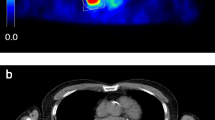Abstract
Objectives
To assess the variability of 18F-FDG-positive volume measurements in lung cancer patients, obtained with different fixed percentages of maximum standard uptake value (SUVmax) thresholds.
Methods
PET dynamic acquisition involving ten frames was performed within 60–110 min post-injection in eight patients. In each lesion (n = 11), volume was automatically outlined in each frame with fixed 40–50–60–70 % of the SUVmax thresholds. Thus, ten volume values for each threshold (V40–50–60–70) were available to calculate relative SD (SDr), and hence relative measurement error (MEr) and repeatability (R). Dependence on SUVmax variability was also assessed.
Results
Mean SDr (<SDr>; %) of volume estimates was found to strongly correlate with threshold value (T; %): <SDr> = 1.626 × exp(0.044 × T) (r = 0.999; P < 0.01). MEr and R for V40 were found to be (95 % CL) 18.9 % and 26.7 %. For all fixed thresholds, in successive frames of an arbitrary lesion, volume estimate inversely correlated with SUVmax (P ≤ 0.02).
Conclusions
A formula allows estimation of the variability of 18F-FDG-positive volumes provided by any fixed percentage of SUVmax threshold, and hence by any thresholding method. It only necessitates conversion of the threshold value into the SUVmax percentage in order to aid quick estimation of volume variability magnitude in current clinical practice.
Key Points
• In oncology, PET is widely used to assess the metabolic active volume
• This paper investigates the variability of 18 F-FDG-positive volumes by thresholding
• A formula is available for estimating this variability for any thresholding method
• For 40 %-SUVmax threshold, measurement error and repeatability are (95 % CL) 18.9 %/26.7 %




Similar content being viewed by others
References
Zasadny KR, Kison PV, Francis IR, Wahl RL (1998) FDG-PET determination of metabolically active tumor volume and comparison with CT. Clin Positron Imaging 1:123–129
Erdi YE, Mawlawi O, Larson SM, Imbriaco M, Yeung H, Finn R, Humm JL (1997) Segmentation of lung lesion volume by adaptive positron emission tomography image thresholding. Cancer 80:2505–2509
Jentzen W, Freudenberg L, Eising EG, Heinze M, Brandau W, Bockisch A (2007) Segmentation of PET volumes by iterative image thresholding. J Nucl Med 48:108–114
Daisne JF, Sibomana M, Bol A, Doumont T, Lonneux M, Grégoire V (2003) Tridimensional automatic segmentation of PET volumes based on measured source-to-background ratios: influence of the reconstruction algorithms. Radiother Oncol 69:247–250
Black QC, Grills IS, Kestin LL, Wong CY, Wong JW, Martinez AA, Yan D (2004) Defining a radiotherapy target with positron emission tomography. Int J Radiat Oncol Biol Phys 690:1272–1282
Nestle U, Schaefer-Schuler A, Kremp S, Groeschel A, Hellwig D, Rube C, Lirsch CM (2007) Target volume definition for 18F-FDG PET-positive lymph nodes in radiotherapy of patients with non-small cell lung cancer. Eur J Nucl Med Mol Imaging 34:453–462
Visser EP, Boerman OC, Oyen WJG (2010) SUV: from silly useless value to smart uptake value. J Nucl Med 51:173–175
Bland JM, Altman DG (1996) Statistics notes: Measurement error. BMJ 313:744–746
Bland JM, Altman DG (1996) Statistics notes: Measurement error proportional to the mean. BMJ 313:106–108
De Ruysscher D, Nestle U, Jeraj R, MacManus M (2012) PET scans in radiotherapy planning of lung cancer. Lung Cancer 75:141–145
Feng M, Kong F-M, Gross M, Fernando S, Hayman JA, Ten Haken RK (2009) Using fluorodeoxyglucose positron emission tomography to assess tumor volume during radiotherapy for non-small-cell lung cancer and its potential impact on adaptive dose escalation and normal tissue sparing. Int J Radiat Oncol Biol Phys 73:1228–1234
Edet-Sanson A, Dubray B, Doyeux K, Back A, Hapdey S, Modzelewski R, Bohn P, Gardin I, Vera P (2011) Serial assessment of FDG-PET uptake and functional volume during radiotherapy (RT) in patients with non-small cell lung cancer (NSCLC). Radiother Oncol 102:251–257
Tylski P, Stute S, Grotus N, Doyeux K, Hapdey S, Gardin I, Vanderlinden B, Buvat I (2010) Comparative assessment of methods for estimating tumor volume and standardized uptake value in 18F-FDG PET. J Nucl Med 51:268–276
Frings V, de Langen AJ, Smit EF, van Helden FH, Hoekstra OS, van Tinteren H, Boellaard (2010) Repeatability of metabolically active volume measurements with 18F-FDG and 18F-FLT PET in non-small cell lung cancer. J Nucl Med 51:1870–1877
Soret M, Bacharach SL, Buvat I (2007) Partial-volume effect in PET tumor imaging. J Nucl Med 48:932–945
de Langen AJ, Vincent A, Velasquez LM, van Tinteren H, Boellaard R, Shankar LK, Boers M, Smit EF, Stroobants S, Weber WA, Hoekstra OS (2012) Repeatability of 18F-FDG uptake measurements in tumours: a meta-analysis. J Nucl Med 53:701–708
Boellaard R (2011) Need for standardization of 18F-FDG PET/CT for treatment response assessments. J Nucl Med 52:93S–100S
Laffon E, de Clermont H, Marthan R (2011) A method of adjusting SUV for injection-acquisition time differences in 18F-FDG PET imaging. Eur Radiol 21:2417–2424
Nakamoto Y, Zadsadny KR, Minn H, Wahl R (2002) Reproducibility of common semi-quantitative parameters for evaluating lung cancer glucose metabolism with positron emission tomography using 2-Deoxy-2-[18F]Fluoro-D-Glucose. Molecular Imaging and Biology 4:171–178
Goldstraw P, Crowley J, Chansky K, Giroux DJ, Groome PA, Rami-Porta R, Postmus PE, Rusch V, Sobin L (2007) The IASLC lung cancer staging project: proposals for the revision of the TNM stage groupings in the forthcoming (seventh) edition of the TNM classification of malignant tumors. J Thor Oncol 2:706–714
Giraud P, Antoine M, Larrouy A, Milleron B, Callard P, De Rycke Y, Carette MF, Rosenwald JC, Cosset JM, Housset M, Touboul E (2000) Evaluation of microscopic tumor extension in non-small-cell lung cancer for three-dimensional conformal radiotherapy planning. Int J Radiat Oncol Biol Phys 48:1015–1024
Author information
Authors and Affiliations
Corresponding author
Rights and permissions
About this article
Cite this article
Laffon, E., de Clermont, H. & Marthan, R. Variability of 18F-FDG-positive lung lesion volume by thresholding. Eur Radiol 23, 1131–1137 (2013). https://doi.org/10.1007/s00330-012-2672-2
Received:
Revised:
Accepted:
Published:
Issue Date:
DOI: https://doi.org/10.1007/s00330-012-2672-2




